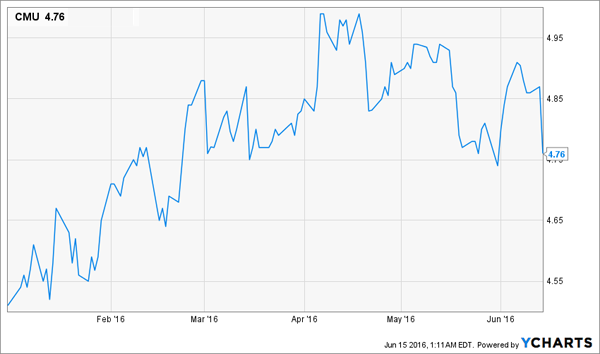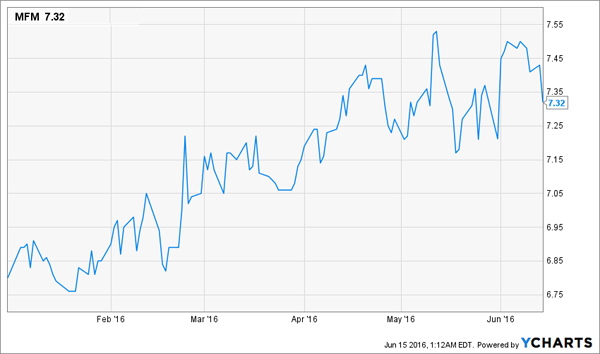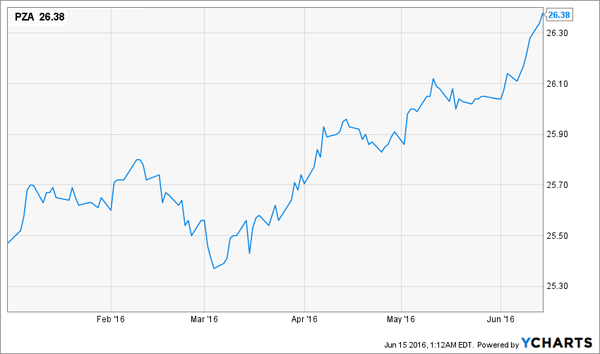If you live in America, you can get tax-free dividends over 5% by investing in incredibly low risk bond funds. And I’m going to show you how to do it today.
You probably know that tax-free is a big deal. If you’re in a 25% tax bracket, a 5% tax-free yield equates to a 7.4% taxable yield. In the top 43.4% bracket? You’re banking a payout above 9%.
How is this possible? Simple—with municipal bonds. “Munis” have been a long-term favorite of retirees because of their tax-exempt status and low default rates, but now is a better time than ever to jump into the market.
Corporate bonds offered a higher yield earlier this year, but those yields have been coming down since February. Now the riskiest corporate bonds are yielding a bit over 7% on average (they were yielding over 10% back in February), meaning investors aren’t getting compensated for the risk.
Meanwhile, Treasury yields are in the toilet. At less than 1.7%, the 10-year U.S. Treasury is flirting with an all-time low, and moves at the Fed may make that yield plummet to a new record. With inflation rising over 2%, the Treasury yield is actually a loser on an inflation-adjusted basis—especially if you look at a decade-long time horizon.
With that, all signs point to munis. But why? For one, they are lower risk than corporate bonds, and that means a lower yield. As I said earlier their preferred tax treatment means their 5% yield is more like 7.4% if your Federal tax rate is 25%. So really, munis are offering as good a yield as corporate bonds but with lower risk.
Yes, I Said Tax-Free
How exactly are munis tax exempt?
For the most part, income from municipal bonds is not taxed at the Federal level. While there are some exceptions, they are rare—and buying a muni bond fund like the ones we recommend (see below) ensures you’ll get just the tax-exempt bonds.
There is one snag, however. Municipal bonds are issued by localities or states, and those bonds are not usually taxed at the state level if they were issued in the same state. For instance, if you live in Georgia and buy bonds issued by any municipality in Georgia, you won’t pay state taxes on those bonds. But if you live in Alabama, you will most likely pay state taxes on the income from the Georgia bond.
For this reason, you can’t expect income from a diversified municipal bond fund to be totally tax-free for you if you live in a state with income taxes. You can get around this pretty easily by buying a fund that only invests in issues from your state, and there are 82 such closed-end funds out there that do exactly that.
Right now my favorites in this world are Eaton Vance’s Pennsylvania Municipal Income Fund (EVP) and Nuveen’s New Jersey Dividend Advantage Municipal Fund (NXJ), which pay yields of 4.3% and 5.2% respectively. Of course, if you’re not in Pennsylvania or Jersey, these funds aren’t going to be much use to you. If that applies to you, go ahead and skip to the end of this article to find out how to get muni funds that avoid Federal and state taxes.
Diversified Muni Funds to Avoid Federal Taxes
Just focusing on Federal taxes, there are some funds that help us get tax-free low-risk income because they have diversified their portfolio across states and leveraged sophisticated credit analysis to determine which of these bonds have the lowest potential for capital losses, ensuring your capital is protected. These funds are also managed by very large firms who have better access to high-quality muni issues than your average investor – another advantage of these “one-click” options.
My favorite right now is the MFS High Yield Municipal Trust Fund (CMU). Often overlooked by the average investor, this fund pays a dividend of over 5.5%—and those checks come monthly. Plus the fund currently trades at nearly a 5% discount to its net asset value after trading at a slight premium just three months ago. That presents us with a great buying opportunity today.
CMU: A Monthly Payer With Upside

A similar story can be seen with another MFS fund—the Municipal Income Fund (MFM), also paying over 5% annual dividends (on a monthly basis) and trading at a 4% discount. The fund hasn’t traded at a premium in three years, but its discount has been declining significantly in the last six months as investors slowly remember this fund has a robust diversified portfolio and a great yield.
MFM Rallies Slowly but Steadily

Chances are high of it coming to a premium, especially if investors flock to munis in the coming months to avoid growing volatility in stocks.
My third muni choice is an ETF—the PowerShares National AMT-Free Municipal Bond Portfolio (PZA), which is attractive for a bunch of reasons. For one, it has an incredibly low management fee—its expense ratio is just 0.28%, and that’s taken out of the fund so you never have to worry about it.
Mr. Market Remembers the Power of Munis

The fund is also geographically diversified, with issues from Texas, Florida, Alabama, Chicago, New York City,and Massachusetts comprising their top holdings. While the fund does hold 2% of its assets in taxable munis, this shouldn’t cause anyone’s tax bill to jump dramatically, while the rest of the portfolio funds its 3.3% yield.
Put these three funds together, and we have a 4.7% average yield in extremely low risk tax-free income. At the same time, we’re insulating ourselves from the increasing insanity of the stock market, which has seen over 11% declines in a matter of days over the last year.
My Favorite Municipal Bond Fund
My favorite municipal bond fund is either a good buy or a great buy today, depending on your tax bracket. Its current 5.8% yield is federal tax-exempt. If you’re in a 25% tax bracket, this equates to a 7.6% taxable yield. In the top 43.4% bracket? You’re banking a 10.2% equivalent payout.
More than 61% of its investments have a AA or AAA rating. And 88% of the paper it owns is investment grade (BBB or better).
When the high priest of fixed income Jeffrey Gundlach picked these funds as his top idea of 2016, this is what he had in mind. And I’ve got 3 more “Bond God favorites” that I’d love to share with you as well. These funds pay 8%, 8.4% and 11% annual dividends – plus they are trading at discount to their net asset value (NAV), which means they have 7-15% quick upside potential too. Click here for more on Gundlach’s take, along with the names and tickers of these three funds, including my muni favorite.
